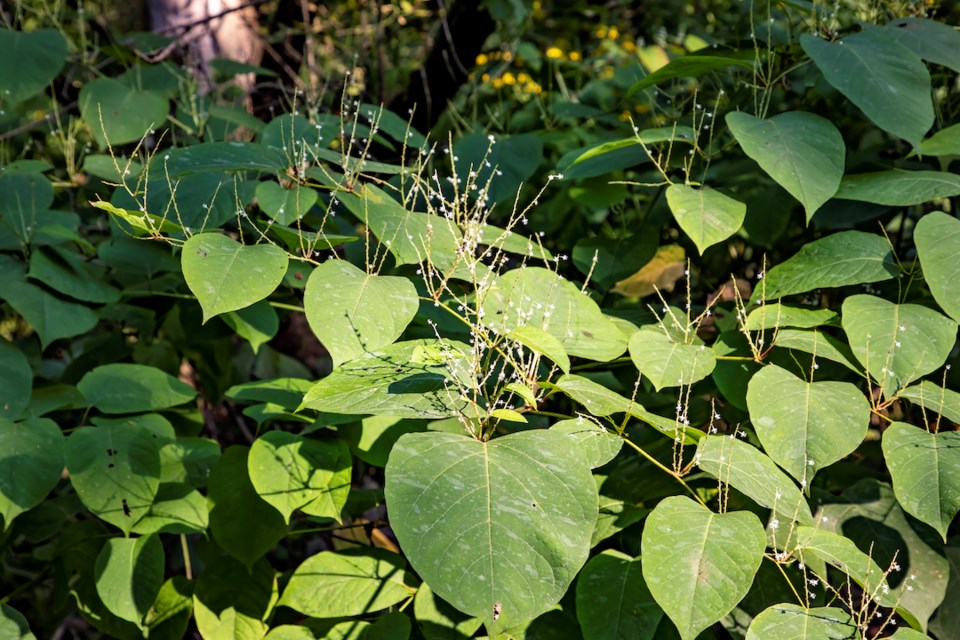Just like how the people love it on the Coast, so do the plants, and sometimes that’s an issue.
Invasive species are a serious threat to any ecosystem, says a draft pest management plan for southern and coastal B.C., which adds that invasive species have the potential to displace native seeds, decrease biodiversity, reduce food for wildlife and more.
The proposed plan, announced in late 2023 by the Ministry of Forests, is intended to provide guidelines for invasive pest management on provincial public lands.
Invasive species are those “not native to the province or are outside of their natural distribution that negatively impact British Columbia’s environment, people and/or economy,” a Ministry of Forests representative said in an email, “Free from their natural enemies and other constraints that keep them in check in their native ranges, invasive species are recognized globally as a significant threat to biodiversity.”
They clarified that this draft plan will be a replacement and merger of three existing plant pest management plans that expire in spring 2024. They added that because plans are only valid for a maximum of five years, these plans are updated and consulted on every five years.
“The overarching strategy and legislation followed, and the plan itself, have not changed substantially, with the exception of updates to the plan to add in additional measures to protect pollinators, increasing our commitment to protecting cultural values and addressing the increasing risk of invasive plants under climate change,” The representative said.
Causes of invasion
While the draft plan lists human activity as the leading cause of invasive plant introductions and their spread, wind, water, domestic and wild animals are also responsible for spreading invasive seeds.
Some of the most common ways humans spread invasive plants include:
- Maintenance on transportation and utility corridors: highways, powerlines and shipyards.
- Forestry operations: skid trail building and machinery movement.
- Mining operations: soil disturbances and creation of permanent openings in the forest canopy.
- Horticultural practices: planting of species that over time become invasive, as well as careless disposal of garden refuse.
- Recreational activities: soil disturbances by all-terrain vehicles and the dumping of aquatic plants into watercourses by boats.
The plan lists a number of traits that allow invasive species to outcompete native plants, such as rapid growth rates, irregular germination and production of phytotoxic chemicals that inhibit the growth of other plants.
Treatment options
The draft lists a number of treatment options when a species or a site is designated as high priority:
- Mechanical and manual control: prescribed burnings, cultivation, pruning, digging, mowing, mulching and sheet mulching.
- Cultural control: Targeted grazing, re-vegetation and fertilization.
- Biological control: using natural, existing, host-specific organisms to reduce an invasive plant population, predominantly done through insects that originate from an invasive plant’s place of origin.
- Chemical control with herbicides: used when no other control method is practical or effective, with the goal of reducing herbicide use on each site over time.
Treatments that are strictly prohibited by this plan include silviculture treatments (removing plants that interfere with tree species), cosmetic treatments (control for aesthetic purposes), and aerial spraying from a helicopter or a fixed-wing plane.
The plan also goes into detail about environmental and community watershed protection procedures, such as a 30-metre no treatment zone to be maintained around all licensed water supply intakes or wells and that herbicides must be removed from any given community watershed within seven days of use, unless they are stored in a permanent structure.
The plan lists more than 20 herbicide active ingredients that may be prescribed, including glyphosate, known for its broad-spectrum weed control, as well as when and where use of each chemical is allowed.
According to the plan, only glyphosate products may be used up to one metre away from the high water mark if used on invasive plants. Glyphosate products can also be selectively applied up to the high water mark of a temporary, free-standing body of water and over a dry stream that is not fish-bearing.
For all other herbicides, a 10-meter pesticide-free zone must be maintained away from the high water mark, unless the label of that herbicide product requires a greater buffer zone.
Also covered in the plan are procedures to protect First Nations interests in traditional food/medicine gathering and culturally significant areas.
Top offenders on the Coast
The Ministry of Forests representative said that the majority of invasive species treated within the Sunshine Coast over the past five years have been invasive knotweed sites across ministry lands, including roadsides.
“In addition to posing a significant risk to fish populations and riparian habitat, they also negatively impact infrastructure such as septic tanks, foundations and roadways as their roots have the ability to grow through asphalt and concrete,” they said.
Another invasive species they mentioned that can be commonly found on the Coast is giant hogweed, a dangerous, toxic species whose sap can cause serious photosensitive burns and damage to the eyes.
The draft plan clarifies that all of the existing populations of invasive plants on provincial public land within the area will not necessarily be treated, “The focus for treatments will be on invasive plants considered high priority that are new to the area, expanding into new geographic areas, and those on the leading edges or gaps between treatment areas where there is a risk of further spread into previously uninhabited, susceptible areas.”
The plan is proposed to come into effect in the spring and would be in place until 2029.
A 30-day public consultation period ran from November to December in 2023, and although the official consultation period has closed, the representative clarified that the government is always open to hearing public suggestions or input and are especially interested in receiving reports of new species. The public can contact the range branch at [email protected].
Jordan Copp is the Coast Reporter’s civic and Indigenous affairs reporter. This reporting beat is made possible by the Local Journalism Initiative.



